1952 Volkswagen Beetle, a name synonymous with affordability, practicality, and a touch of whimsy, emerged from the ashes of post-war Germany. It wasn’t just a car; it was a symbol of hope, a testament to German ingenuity, and a harbinger of a new era of mobility.
The Beetle, conceived by the visionary Ferdinand Porsche, defied conventional automotive design, embracing an air-cooled engine and unibody construction. This revolutionary approach not only made the car incredibly affordable but also remarkably durable, setting the stage for its global dominance.
The Beetle’s iconic shape, with its rounded curves and compact dimensions, was more than just aesthetics. It was a reflection of its purpose: to provide affordable transportation for the masses. Its design was a masterclass in efficiency, maximizing interior space while minimizing production costs.
The Beetle became a symbol of the German “economic miracle,” a testament to the country’s resilience and its ability to rise from the ashes of war.
Historical Context
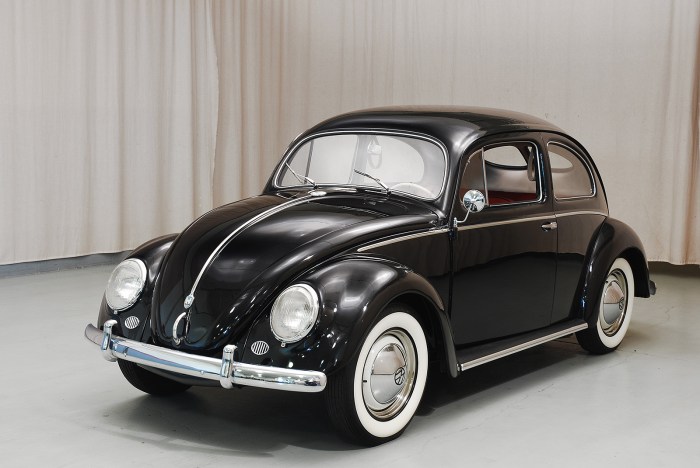
The Volkswagen Beetle, affectionately known as the “Bug,” emerged from the ashes of World War II, a testament to Germany’s resilience and the vision of Ferdinand Porsche. The war had devastated Germany’s economy and infrastructure, leaving its people in dire need of affordable and reliable transportation.
This context played a crucial role in shaping the Beetle’s design and its enduring legacy.
Post-War Germany and the Need for Affordable Transportation
Post-war Germany was a nation grappling with economic hardship and a desperate need for rebuilding. The war had decimated its industrial base, leaving its citizens with limited access to basic necessities, including transportation. The demand for affordable and reliable vehicles was immense, as people sought to rebuild their lives and navigate the challenges of a shattered economy.
The Volkswagen Beetle emerged as a beacon of hope, offering a practical and accessible solution to this pressing need.
Design and Comparison with Other Vehicles
The Beetle’s design, a stark departure from the bulky and luxurious vehicles of the time, was a reflection of its intended purpose: affordability and practicality. Its compact size, air-cooled engine, and simple construction made it inexpensive to produce and maintain.
Unlike the American cars of the era, which were characterized by their large engines and lavish interiors, the Beetle prioritized efficiency and functionality. It was a vehicle designed for the masses, not the elite.
Ferdinand Porsche’s Vision and Impact
Ferdinand Porsche, the visionary engineer behind the Beetle, was a driving force in shaping the automotive landscape of the 20th century. His belief in the power of simple and efficient design, combined with his understanding of the German people’s needs, led to the creation of the Beetle.
The car’s success not only revolutionized personal transportation in Germany but also influenced automotive design worldwide. Its impact extended beyond its technical innovations, becoming a symbol of post-war optimism and German engineering prowess.
Design and Engineering
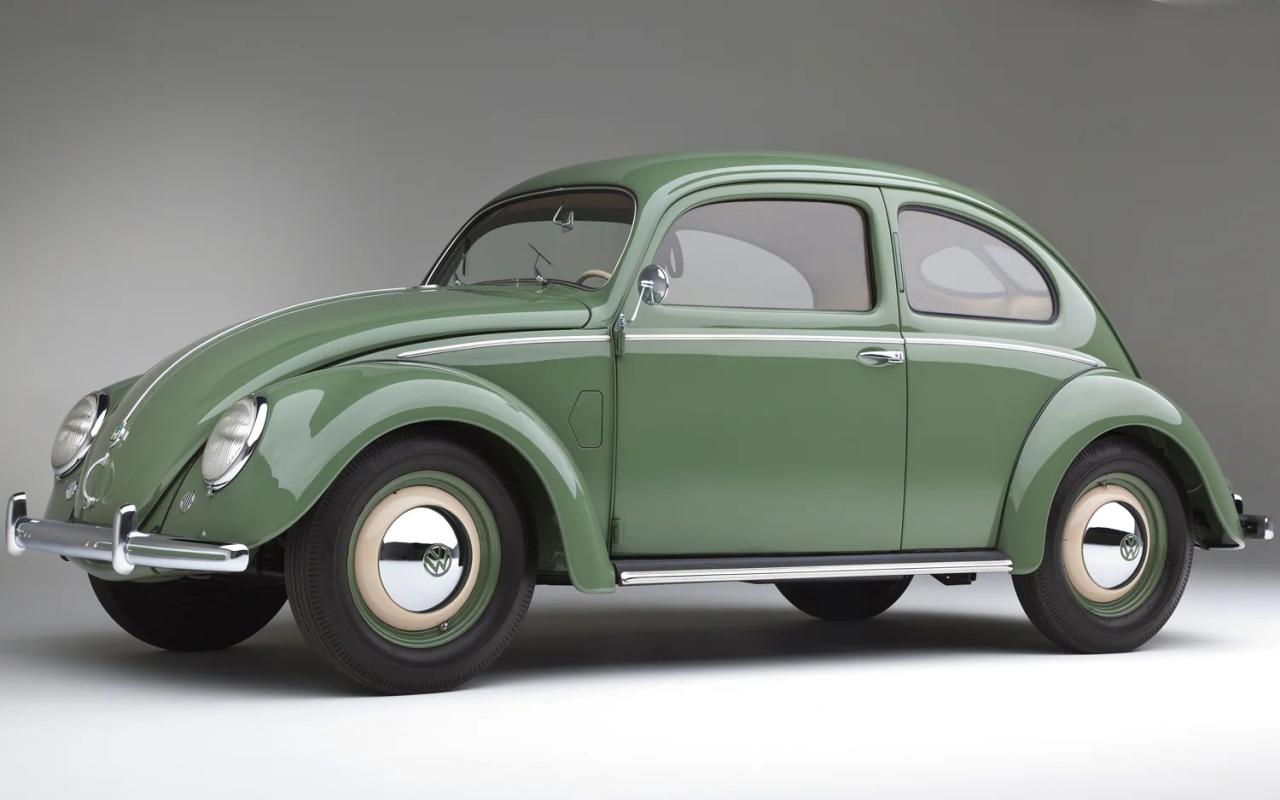
The Volkswagen Beetle’s design and engineering were revolutionary for its time, offering a unique blend of affordability, practicality, and innovative features. It became a global icon, known for its distinctive shape, robust construction, and air-cooled engine.
Unibody Construction and Air-Cooled Engine
The Beetle’s design was driven by a desire for simplicity and efficiency. Ferdinand Porsche, the designer, opted for a unibody construction, where the body and chassis were integrated into a single unit. This eliminated the need for a separate frame, reducing weight and production costs.
The Beetle also featured an air-cooled, rear-mounted engine, a design choice that offered several advantages. Air cooling eliminated the need for a heavy and complex cooling system, further contributing to the car’s lightness. It also allowed for a lower center of gravity, enhancing handling and stability.
The 1952 Volkswagen Beetle, with its iconic rounded shape and air-cooled engine, revolutionized the automotive landscape. While it was a hit in Europe, the Beetle’s popularity in the United States exploded in the 1960s. This iconic car paved the way for its successor, the 1979 Volkswagen Super Beetle , which offered more interior space and a slightly more powerful engine.
The Super Beetle continued to carry the torch of the original, further cementing the Volkswagen brand’s legacy of reliability and affordability.
Distinctive Shape and Affordability
The Beetle’s distinctive rounded shape was not just an aesthetic choice. It was a result of meticulous engineering and design considerations. The rounded body was aerodynamically efficient, reducing drag and improving fuel economy. The curved surfaces also facilitated efficient stamping and assembly, further lowering production costs.The Beetle’s compact size and simplified design made it incredibly affordable.
The 1952 Volkswagen Beetle, a symbol of post-war Germany, was a testament to simple, yet effective engineering. Its iconic design, with its rounded curves and rear-mounted engine, captured the hearts of millions. This legacy of affordability and reliability continued with the introduction of the 1993 Volkswagen Cabriolet , a convertible that brought a touch of open-air freedom to the brand.
While the Cabriolet offered a modern twist, it still retained the core values of its predecessor, the Beetle, making it a timeless classic.
The use of readily available materials, like steel and rubber, and the elimination of complex components, such as a separate chassis, kept the manufacturing costs low. This affordability made the Beetle accessible to a wider audience, contributing to its immense popularity.
Technical Specifications Compared to Competitors
The following table compares the Beetle’s technical specifications to its competitors in 1952:| Feature | Volkswagen Beetle | Ford Model T | Chevrolet Bel Air ||—|—|—|—|| Engine | 1.2 L air-cooled, 4-cylinder | 2.9 L petrol, 4-cylinder | 2.3 L petrol, 6-cylinder || Power | 25 hp | 20 hp | 105 hp || Transmission | 4-speed manual | 3-speed manual | 3-speed manual || Length | 150.5 in | 153 in | 198 in || Width | 59 in | 55 in | 75 in || Height | 56 in | 63 in | 63 in || Weight | 1,580 lbs | 1,250 lbs | 3,150 lbs || Fuel economy | 35 mpg | 25 mpg | 18 mpg || Price | $995 | $550 | $1,650 |As you can see, the Beetle’s compact size, lightweight design, and air-cooled engine made it significantly more fuel-efficient and affordable than its American counterparts.
While the Beetle lacked the power and luxury of the Chevrolet Bel Air, its simplicity and practicality made it a popular choice for families and individuals seeking an economical and reliable mode of transportation.
Cultural Impact
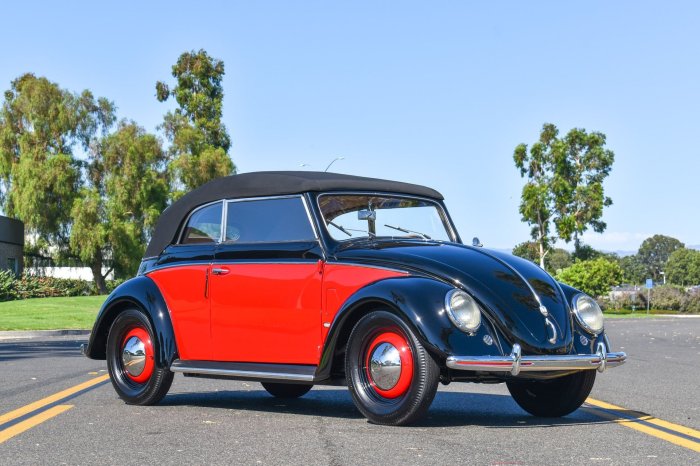
The Volkswagen Beetle’s cultural impact extends far beyond its status as a simple car. It became a symbol of postwar Germany, embodying the nation’s resilience and economic recovery. The Beetle’s global popularity cemented its place in popular culture, influencing movies, music, and fashion.
The Beetle’s Role in the German Economic Miracle
The Beetle’s production and popularity played a significant role in Germany’s economic recovery after World War II. The car became synonymous with the “Wirtschaftswunder,” or economic miracle, a period of rapid economic growth that transformed Germany from a war-torn nation to a thriving industrial powerhouse.
The Beetle’s affordability and practicality made it accessible to a broad range of Germans, contributing to the rise of a new consumer class and a surge in car ownership. The Beetle became a symbol of optimism and hope for a better future, embodying the spirit of postwar Germany.
The Beetle’s Influence in Popular Culture
The Beetle’s influence on popular culture is undeniable. Its iconic design and whimsical personality made it a popular choice for filmmakers, musicians, and writers. Here are some notable examples:
- The Beetle’s most famous appearance in film was in the 1968 Disney movie “The Love Bug,” where it was portrayed as a sentient, racing car with a mischievous personality. The film was a huge success, further solidifying the Beetle’s place in popular culture.
- The Beetle’s association with counterculture and youth rebellion was further cemented by its appearance in the 1969 film “Easy Rider,” where it was driven by a group of young, free-spirited bikers.
- The Beetle also appeared in numerous other films, including “Herbie Goes to Monte Carlo” (1977), “The Cannonball Run” (1981), and “The Fast and the Furious” (2001), showcasing its versatility and appeal across different genres.
- Musicians like The Beatles, The Beach Boys, and The Rolling Stones used the Beetle as a symbol of freedom and rebellion in their music videos and album covers.
- The Beetle’s distinctive shape and design inspired numerous artists and designers, who incorporated its elements into their work.
The Beetle’s Design Influence on Other Products, 1952 Volkswagen Beetle
The Beetle’s design has been a source of inspiration for countless products and brands over the years. Its simple yet distinctive lines, rounded curves, and playful personality have been adapted and reinterpreted across various industries. Here are some examples:
- The Beetle’s design has been adapted for everything from furniture and household appliances to toys and clothing.
- The Beetle’s iconic shape has been incorporated into logos and branding for companies like Coca-Cola and Apple.
- The Beetle’s influence can be seen in the design of other cars, such as the Fiat 500 and the Mini Cooper.
Production and Marketing: 1952 Volkswagen Beetle
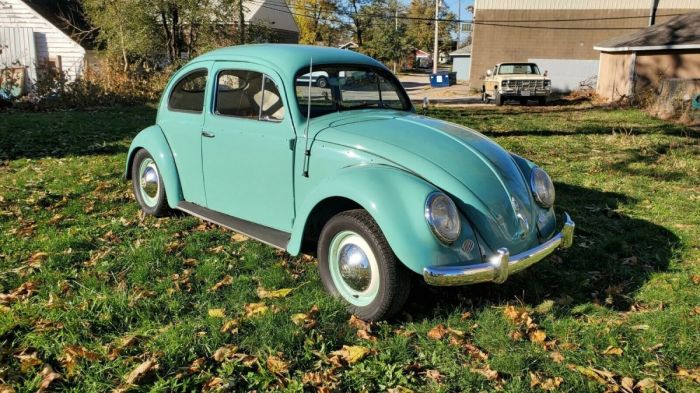
The Volkswagen Beetle’s production and marketing strategies were instrumental in its remarkable success. The car’s simple design, affordable price, and clever marketing campaigns made it a global phenomenon.
Production Process
The Beetle’s production process was characterized by efficiency and innovation. The car was designed to be easily assembled, using a limited number of parts and standardized components. This approach allowed for mass production and kept costs low.
- Initial Design:Ferdinand Porsche’s initial design for the Beetle, known as the “KdF-Wagen,” emphasized simplicity and affordability. The car featured a compact, air-cooled engine, a robust chassis, and a unibody construction.
- Assembly Line:Volkswagen adopted the assembly line system, which revolutionized automobile production. This system involved breaking down the production process into smaller, specialized tasks, enabling workers to focus on specific areas and improve efficiency.
- Standardized Components:Volkswagen used standardized components, such as engines, transmissions, and suspension parts, across different models. This reduced manufacturing costs and simplified maintenance.
- Continuous Improvement:Volkswagen constantly sought to improve the Beetle’s production process. Over the years, the company introduced various innovations, such as the use of robotics and automation, to further streamline production.
Marketing Strategies
Volkswagen’s marketing strategies were crucial in establishing the Beetle’s image and appeal to diverse consumer groups. The company used a combination of traditional and innovative approaches to reach its target audiences.
The 1952 Volkswagen Beetle, a symbol of postwar Germany, wasn’t just a car; it was a cultural phenomenon. But while the Beetle was all about individual mobility, Volkswagen also recognized the need for larger, more versatile vehicles. Enter the 1972 Volkswagen Type 2 , a van that became synonymous with the hippie movement and a symbol of freedom.
The Beetle may have been a compact icon, but the Type 2 offered a different kind of freedom, a space for exploration and adventure, making it a perfect counterpart to the iconic Beetle.
- Affordable Pricing:The Beetle was marketed as a practical and affordable car for the masses. Its low price point made it accessible to a wider range of consumers, especially those seeking reliable and economical transportation.
- Targeted Advertising:Volkswagen targeted its advertising campaigns to specific demographics, such as young families, students, and urban dwellers. The company used catchy slogans and relatable imagery to resonate with its target audiences.
- Building a Brand Identity:Volkswagen created a strong brand identity for the Beetle, emphasizing its reliability, durability, and affordability. The car became associated with values such as practicality, simplicity, and freedom.
- Global Marketing:Volkswagen expanded its marketing efforts globally, adapting its campaigns to different cultures and markets. The company leveraged its international presence to build a global brand for the Beetle.
Production Timeline
The Beetle’s production history is marked by significant milestones, including major updates and redesigns.
- 1938:The first Beetle prototype, known as the “KdF-Wagen,” was unveiled.
- 1945:Production resumed after World War II, with the car now known as the “Volkswagen.”
- 1952:The Beetle was introduced to the United States, marking the beginning of its global success.
- 1967:The Beetle surpassed the Ford Model T as the world’s best-selling car.
- 1974:The Beetle underwent a significant redesign, featuring a larger engine and improved safety features.
- 1998:The original Beetle’s production ended after more than 65 years.
- 1998:Volkswagen launched the “New Beetle,” a modern interpretation of the classic design.
- 2011:The “New Beetle” was replaced by the “Beetle,” featuring a more streamlined and sporty design.
- 2019:Production of the “Beetle” ended, marking the end of an era.
Legacy and Evolution
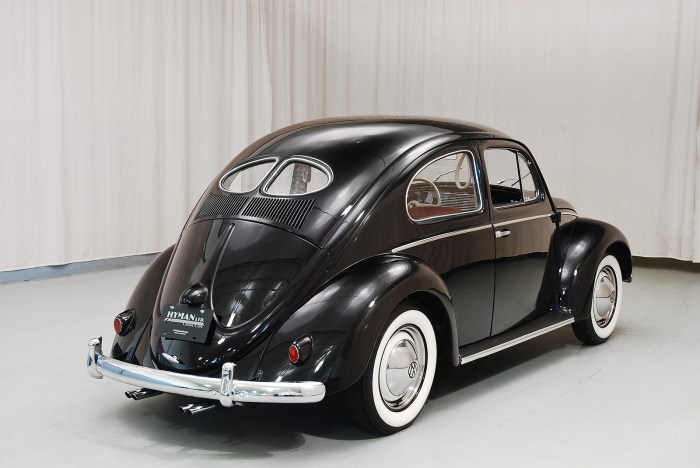
The Volkswagen Beetle’s legacy extends far beyond its impressive production numbers. It’s a testament to the enduring power of simplicity, affordability, and a unique design that captured the hearts of generations. The Beetle’s impact on the automotive industry is undeniable, shaping trends and inspiring new approaches to car design and production.
Enduring Popularity and Impact
The Beetle’s popularity wasn’t just a fleeting fad. It became a cultural icon, transcending geographical boundaries and societal divisions. This enduring appeal can be attributed to several factors:
- Affordability:The Beetle was designed to be a practical and affordable car for the masses, a concept that resonated with people worldwide. It offered a reliable mode of transportation without breaking the bank.
- Durability:The Beetle was known for its robust construction and ability to withstand harsh conditions. Its simple design meant fewer parts to break down, making it a reliable choice for daily commutes and long journeys.
- Unique Design:The Beetle’s distinctive shape, inspired by the iconic “KdF-Wagen” designed by Ferdinand Porsche, was instantly recognizable and became synonymous with the brand. Its round, friendly design appealed to a wide range of consumers.
- Cultural Significance:The Beetle became a symbol of the counterculture movement in the 1960s, embraced by artists, musicians, and those seeking a break from traditional norms. Its association with freedom and individuality further solidified its place in popular culture.
Key Innovations and Design Elements
The Beetle’s design wasn’t just about aesthetics. It incorporated innovative engineering solutions that influenced the automotive industry for decades to come:
- Air-cooled engine:The Beetle’s air-cooled engine was a revolutionary concept at the time. It eliminated the need for a bulky and complex cooling system, making the car lighter and more efficient. This technology later influenced the design of other small cars and motorcycles.
- Unitary construction:The Beetle’s body and chassis were integrated into a single unit, a design that improved rigidity and strength while simplifying production. This approach became a standard practice in the automotive industry, particularly for small cars.
- Independent suspension:The Beetle featured independent suspension on all four wheels, providing a comfortable ride and improved handling. This innovation was later adopted by many car manufacturers, enhancing driving experience and safety.
- Front-engine, rear-wheel drive layout:While not entirely unique, the Beetle’s front-engine, rear-wheel drive configuration was a common layout for small cars at the time. It offered a simple and efficient design, with the engine positioned over the front axle for optimal weight distribution.
Evolution and Discontinuation
The Beetle wasn’t static. Over the years, it underwent several updates and revisions, reflecting evolving tastes and technological advancements. While retaining its core design principles, later iterations introduced:
- Increased engine size and power:Later models offered larger engines, providing more power and improved performance.
- Safety improvements:Safety features like seat belts and disc brakes were gradually introduced, enhancing occupant protection.
- Modernized interiors:Interior design evolved with more comfortable seats, updated dashboards, and improved ergonomics.
- New body styles:In addition to the classic hatchback, the Beetle was offered in convertible and station wagon versions, expanding its appeal to a wider range of buyers.
Despite its enduring popularity, the Beetle eventually faced challenges. The rise of fuel-efficient and aerodynamically designed cars, coupled with stricter safety regulations, led to a decline in sales. After a long and successful run, the original Beetle was discontinued in 2003, leaving a void in the hearts of many.
Last Recap
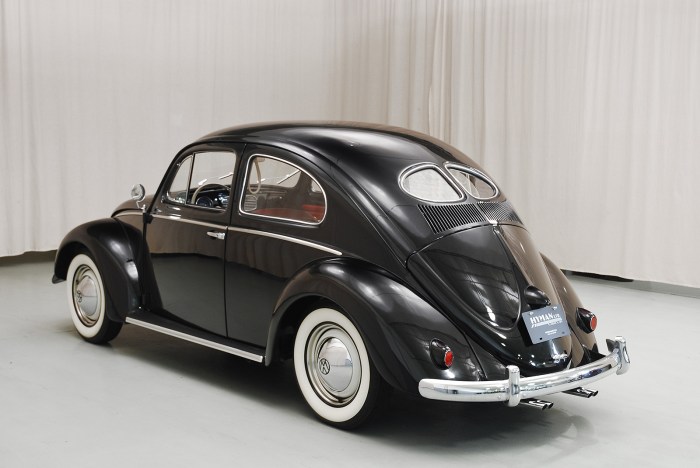
The 1952 Volkswagen Beetle wasn’t just a car; it was a cultural phenomenon. It became a symbol of peace, freedom, and a generation’s optimism. Its enduring popularity, spanning decades and continents, is a testament to its timeless design and its ability to connect with people on a deeper level.
The Beetle’s legacy extends far beyond its production run; it inspired generations of car designers and continues to captivate car enthusiasts around the world. Its story is a reminder that sometimes, the most iconic designs are born from necessity, ingenuity, and a touch of magic.